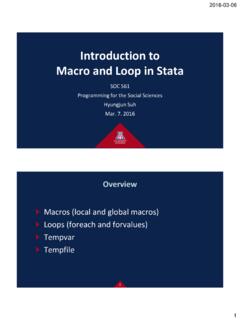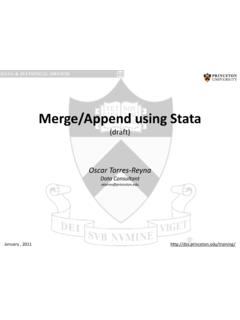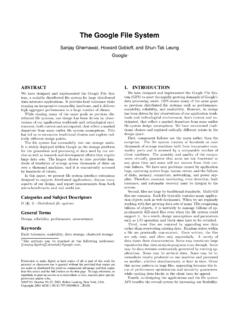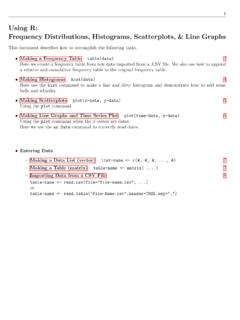Transcription of A QUICK STATA GUIDE: APPEND, MERGE, AND COLLAPSE 2. …
1 SOC 561: Programing for the Social Sciences Community Resource append , merge , and COLLAPSE Steven Lizzol A QUICK STATA GUIDE: append , merge , AND COLLAPSE 1. append 2. merge 3. COLLAPSE APPENDIX - A QUICK word on preserve / restore - merge Warning Before we begin, it is highly recommended that when performing append , merge , or COLLAPSE procedures the user performs the preserve / restore command beforehand to ensure their data are maintained. If you need a QUICK review, see the appendix. 1. append Adding cases / observations Command: append using The append command combines the dataset in memory, known as the master dataset, with a dataset on disk, known as the using dataset. Typically, a user would implement the append command when they would like to add observations to an existing dataset with the same or similar variables.
2 Let s assume we are interested in combining the following datasets: Each dataset provides three variables: city, population, and square miles. All variables are named and formatted the same for each dataset. To append to we use the following: The command produced a new dataset that combined the observations from the master dataset, ( ) with the using dataset ( ). Notice no new variables with the exception of new_obs were created in the process; only additional observations. The additional commands after the coma are optional and are not required to execute the command. The , generate (new_obs) option above provided a new_obs variable that identifies which observations were appended to the master dataset. Additionally, the options nolabel nonotes prevented any labels or notes from the using dataset copying over to the appended master dataset.
3 A different option allows the user to omit variables from the using dataset. For example: The keep (population) identified only one variable to copy over while leaving the other fields ( city and sq_miles for this example) as missing. If you attempt to append a using dataset with variables that do not match with the master dataset, they will be added to the appended dataset as additional variables. For example: Even though the variables sq_miles and sqr_miles provide the same measure, they remained separate and provided missing data in observations where the variable name did not match. Another consideration is if you are attempting to append a using dataset with a variable by the same name as the master dataset, but in a different format. For example, if you attempt to append the using dataset with a string variable (sq_miles) to a master dataset with a numeric variable by the same name (sq_miles), you will receive the following error message: If we use the force option in this situation, STATA will append the using dataset and inform you that the variable from the using dataset will assume the format of the master dataset.
4 Additionally, the values form the using datasets will change to missing. Major Options: generate(newvar) newvar marks source of resulting observations keep(varlist) keep specified variables from appending dataset(s) nolabel do not copy value-label definitions from dataset(s) on disk nonotes do not copy notes from dataset(s) on disk force append string to numeric or numeric to string without error For additional information and examples, you can view the online append manual here. 2. merge Adding variables Command: merge using The merge command combines the dataset in memory, known as the master dataset, with a dataset on disk, known as the using dataset. While append added observations to a master dataset, the general purpose of merge is to add variables to existing observations. In its simplest form from past STATA versions (the command above), datasets are merged based on their observation (or row) order ( , the first observation is paired with the first outcomes for each variable).
5 This older syntax is not recommended as it can be potentially dangerous if the two datasets are sorted differently or possess more or less id variables (see merge warning in the appendix). You can produce the same results using the following command recognized by newer STATA versions: merge 1:1 _n using filename However, the new STATA commands in versions 10 or later mitigate chances for mismatched variables and observations. We will now focus on the two primary types: one-to-one and a one-to-many (or many-to-one ). One-to-one merging: Command: merge 1:1 varlist using filename For this command 1:1 specifies that there is one id variable in each dataset that needs to be merged. For example, imagine you had a master dataset, that possessed the id variable city with multiple size variables ( , population, total square miles), and a separate using dataset, that possessed the same id variables with corresponding market variables ( , number of grocery retailers and total GDP).
6 Given that you wanted to merge these two datasets and the presence of one identifier, city in this case, you would perform a one-to-one merge . STATA merged the using dataset, variables to the corresponding observations in the city variable within the master dataset, Also, the merge occurs based on the id variable regardless of sort order. The command will also create an additional variable merge that identifies if an observation was matched in the merge . It provides three indicators: 1 = observation found only in the master dataset 2 = observation found only in the using dataset 3 = observation found in both master and using dataset (complete match) The Kansas City observation received a 2 identifier because this observation was only provided in the using dataset. Additionally, it resulted in missing values for the variables in the master dataset.
7 The merge can occur based on other id variables if desired. Many-to-one & one-to-many merge : Command: merge 1:m varlist using filename merge m:1 varlist using filename You can also merge datasets that have similar id variables with observations at different levels of analysis. For example, let s suppose in addition to the and files, you have a dataset with variables that capture a person s city of residence and yearly income. This dataset includes a personal id variable. using city as the id variable, you can merge as the using dataset with as the master dataset. Performing a many-to-one merge produces the following output: Now, all city level measures are assigned to each person depending on which city they reside in. Notice that values for population and sq_miles are missing since Kansas City is an identifier only provided in the dataset, thus the _merge==1 result.
8 If we attempt a one-to-many command with the same using and master dataset arrangement, STATA will present an error: The dataset fails to provide an id variable that STATA can recognize as a unique identifier ( , Boston is assigned to more than one observation). If we switch the datasets where is the master dataset and is the using dataset, a one-to-many merge is possible. Notice the one-to-many merged dataset sorted on city and per_id produces the same output as the many-to-one merged dataset. A many-to-many merge can occur when you are unaware of how many of the same identifiers exist between two datasets, but believe there is at least one pair. A many-to-many command is not recommended. As stated in the STATA Data Management Reference Manual (Release 15): Because m:m merges are such a bad idea, we are not going to show you an example.
9 If you think that you need an m:m merge , then you probably need to work with your data so that you can use a 1:m or m:1 merge . It is recommended that the user is familiar enough with the datasets they desire to merge that a many-to-one or one-to-many is used for the desired outcomes. Major options: keepusing (varlist) allows you to merge only select variables from the using dataset. generate (newvar) changes _merge variable name to one of your choosing nogenerate _merge variable not created after a merge nolabel prevents value/label definitions copying over from the using dataset nonotes prevents notes copying over form the using dataset noreport prevents the match results from showing after the merge For additional information and examples, you can view the online merge manual here. 3. COLLAPSE Command: COLLAPSE (statistic) var1, by (var2) This command takes an open (or master) dataset and creates a new dataset by summarizing statistics on a selected variable.
10 Let s use the dataset to go through some examples. For these examples we add three new variables: female (1 = female, 0 = male), like_live (rating of how much a person likes the city they live in (1 = completely dislike to 6 = completely like), and willing_move (rating of how willing a person is to move to a different city (1 = strongly unwilling to 6 = strongly willing). The COLLAPSE command will allow us to find a statistic by a specific variable. For example, if we wanted to find the mean yearly income for each city based on the individual dataset, we would use the following: The command collapsed all individual yearly incomes in the dataset and produced a new dataset presenting the mean for each city. By default, COLLAPSE will provide the mean for each numeric variable listed. The COLLAPSE output can be changed to a variety of statistics.))









